Smoked Beef Back Ribs
On October 03, 2022 (Updated October 24, 2023)
This post may contain affiliate links. Please read our disclosure policy.
Juicy and tender, these smoked beef back ribs are a BBQ bucket list, must-try item. Beef back ribs are best smoked low and slow until they melt in your mouth.
What are Beef Back Ribs?
Beef back ribs come from the rib primal cut on a cow. The exact same area where you find delicious and fatty rib eyes or prime rib. In fact, beef back ribs are just the bones that have been removed during the trimming process for boneless rib eye steaks or boneless prime rib roasts. They have all the fatty marbling and flavor that those same cuts are known for, which makes them perfect to cook on the smoker. A typical rack of back ribs can include anywhere from 7-12 bones and weigh between 2.5-4 pounds.
Now, back ribs are different from the giant beef ribs and short ribs we have posted recipes about before, so make sure you’ve got the right cut for this cook.
Where to Buy Beef Back Ribs?
Butchers can get more money per pound selling the high-value rib eye meat on top of the bones than they can sell the meat as back ribs. They trim back ribs down, leaving little meat above the bone. This aggressive trimming means you can see some of the bones peeking through the meat. Try and find back ribs with as much meat on them as you can and look for good fat marbling.
Beef back ribs are pretty affordable since they tend to be cast-offs from the rib eye production process. Look in the beef section of your grocery store or go right up to the counter and ask. A good butcher will be more than willing to sell you the back ribs and earn some money on a cut that often gets discarded. If you can’t find them in a store near you, we have ordered them from Felton Angus Beef with great success.
Smoked Beef Back Ribs
Now that we know what beef ribs are and how to buy them, let’s talk about the best method for cooking them. Beef ribs absolutely shine cooked on the smoker. Low and slow heat breaks down the tight connective tissues between the ribs. Smoke adds the perfect BBQ flavor while simultaneously creating that coveted mahogany bark on the exterior. There is nothing like salty, juicy, tender, smoky beef.
Oak and cherry is my favorite combo for beef ribs. Oak is an amazing flavor complement to beef and cherry gives me that coveted dark red color. My husband Todd loves Texas BBQ, so when we are doing beef, we keep it simple with a salt and pepper rub (like my Hey Grill Hey Beef Rub!) and post oak in the pit.
How to Smoke Beef Back Ribs
I’ve got full, detailed instructions in the recipe card below, but this section will help give an overview of what to expect with this smoke. Here’s how to smoke beef back ribs:
- Preheat your smoker. Fire up the smoker and preheat to 275 degrees F. This hotter temp gives you plenty of smoke on these thin ribs and helps to keeps them super moist.
- Slather and season. A light coating of classic yellow mustard acts as a binder for the seasoning. I recommend using my Hey Grill Hey Beef Rub (it won the NBBQA 2020 Award of Excellence 1st place in their Beef Seasoning category!). It’s a great dry rub for all your food.
- Smoke. Set those ribs bone side down on the grates, close the lid, and smoke the ribs for 3 hours (no peeking!).
- Wrap the ribs. After 3 hours, your ribs should now be a nice dark color, the bark is fairly set, and the internal temperature reading is at about 165 degrees F. Next, wrap the ribs in peach butcher paper to help keep them moist, encourage a darker bark, and speed along the cooking process.
- Finish smoking. Return the wrapped ribs to the smoker and close the lid. Continue to smoke for around 1 1/2 to 2 hours. Smoke until they reach an internal temperature of around 202 degrees F.
- Rest, slice and serve. Pull your finished ribs out of the smoker and allow them to rest for at least 30 minutes, or up to an hour, before slicing and serving.
I like to keep these ribs nice and simple with a dry rub and no sauce. You can always serve your ribs with some sauce for dipping if you want some extra flavor with your food (My Everything BBQ Sauce is a major winner!).
How Long to Smoke Beef Back Ribs
The whole smoking, wrapping, and resting process, takes about 5 1/2 hours. However, I always recommend cooking to temperature and texture instead of just setting a timer. The timelines with BBQ are always just loose suggestions to keep you on track with your cooks. These ribs could be done in as little as 4 hours or they could take closer to 6, depending on how thick your ribs are, the temperature in your smoker, and other factors.
After wrapping the ribs, you’ll want to start checking them after 90 minutes in the smoker. You are looking for texture/feel and temperature. The ribs are done when they are very flexible and the meat has pulled back significantly from the end of the bones. When you insert your meat thermometer, it should glide into the meat like it is softened butter. Be sure to use a nice instant-read thermometer to check those temperatures!
Smoked Beef Back Rib FAQ’s:
Any time I share a recipe for a low and slow recipe, I have a few common questions that rise to the surface. Hopefully, I cover them all here for you so that your beef ribs turn out perfect the first time. If you have a question I didn’t answer, leave it in the comments section below!
Can I cook beef back ribs in the oven or on a regular grill?
Technically, yes. You can cook beef back ribs in the oven. However, they won’t be smoked beef back ribs. You will miss out on a lot of the flavor and color you get from the smoker. If you have a gas grill, I have some simple tips for smoking on a gas grill that could help you out!
Can I wrap with foil instead of butcher paper?
Yup! The ribs may cook more quickly in foil, so keep an eye out for that. It is also likely that you’ll see a softer bark that isn’t as dark since butcher paper allows the ribs to breathe and foil creates more of a steaming effect.
Do I need to use the mustard slather?
Nope! I love to use mustard as a slather for ribs (and briskets, and pork shoulders) because it acts as both a binder for the dry rub and a surface tenderizer. This helps create a really nice bark on the outside of smoked meats. You won’t actually taste the mustard when all is said and done. If you are allergic to mustard, I have had success with using hot sauce or viniagrette dressings to get similar results.
More Beef Ribs Recipes
It’s no secret that Hey Grill Hey loves beef ribs! If you’d like to try your hand at more beef rib recipes, check out the links below.
Beef Back Ribs Recipe
Once you finish cooking this beef back ribs recipe, come back and leave a comment about how it turned out. Hey Grill Hey is dedicated to creating an environment of supportive and backyard-friendly BBQers that are here to help you become a backyard BBQ hero.
This post was originally published in April 2020. We recently updated it with more information and helpful tips. The recipe remains the same.
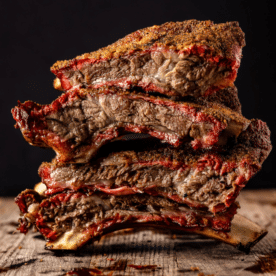
Smoked Beef Back Ribs
Video
Ingredients
- 1 rack beef back ribs
- 3 Tablespoons yellow mustard
- 2 Tablespoons Hey Grill Hey Beef Rub or equal parts salt and pepper
Instructions
- Preheat. Preheat your smoker to 275 degrees F for indirect smoking using oak wood.
- Prep the ribs. Remove the ribs from the package and place them bone-side up on a large work surface. Use a butter knife to loosen the membrane attached to the ribs and then pull the membrane away with a paper towel. If the membrane is already removed by your butcher, move on to seasoning.
- Season. Slather the ribs with yellow mustard and then season liberally on all sides with Beef Rub or equal parts salt and pepper. This step will help the rub adhere to the ribs and create a nice dark bark.
- Smoke. Place the ribs bone side down on the smoker grates, close the lid, and smoke for about 3 hours. At this point, the exterior of the ribs should have darkened significantly. If you take a read of the temperature with an internal thermometer, it should be near 165 degrees F.
- Wrap the ribs. Once the ribs hit 165 degrees F remove them from the grill. On a large work surface, roll out a large piece of peach butcher paper (foil will also work, but it will soften the bark in the end). Place the ribs on the butcher paper and wrap tightly.
- Finish smoking. Return the wrapped ribs to the smoker and continue cooking for approximately 2 hours, but start checking the ribs after 90 minutes of being wrapped (you will be going by temperature and feel, not by time).
- Cook to temperature. Continue to smoke the wrapped ribs until they reach an internal temperature around 202 degrees F. You want your ribs to be very flexible and the meat to have pulled back significantly from the end of the bones. When you insert your meat thermometer, it should glide into the meat like it is softened butter.
- Rest, slice, and serve. Remove the beef back ribs from the smoker and allow to rest for 30 minutes before slicing into individual ribs and serving. (Serve with a side of BBQ sauce, if desired).
Nutrition
Nutrition information is automatically calculated, so should only be used as an approximation.


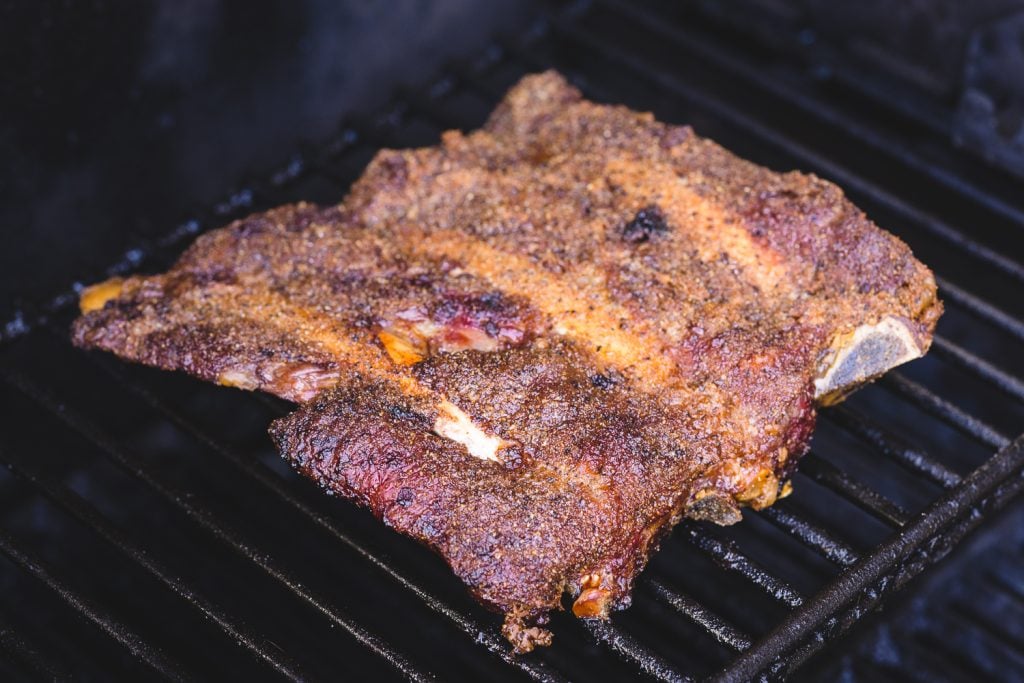

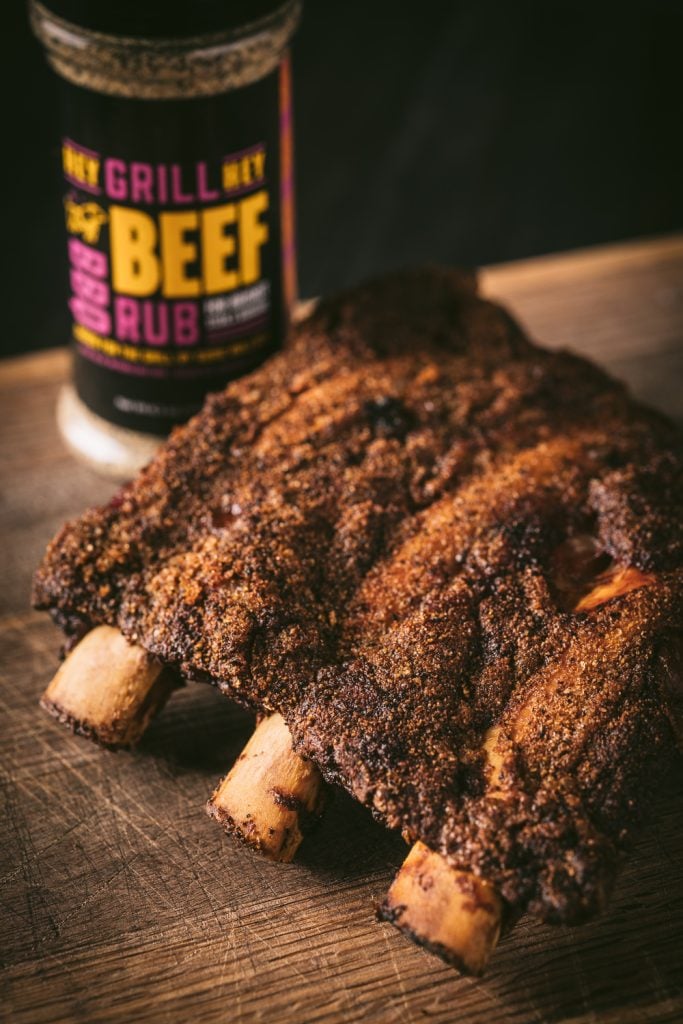

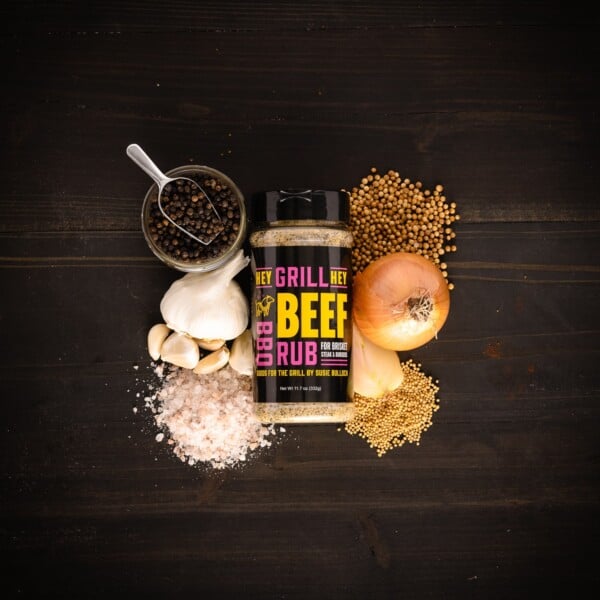
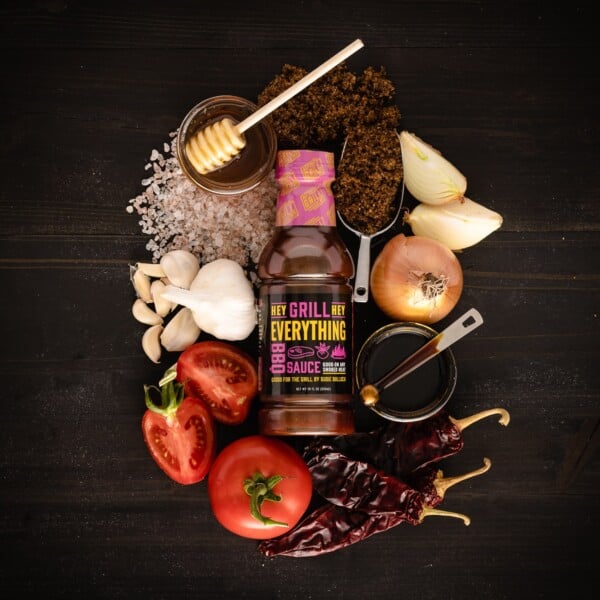
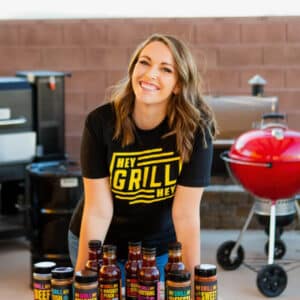
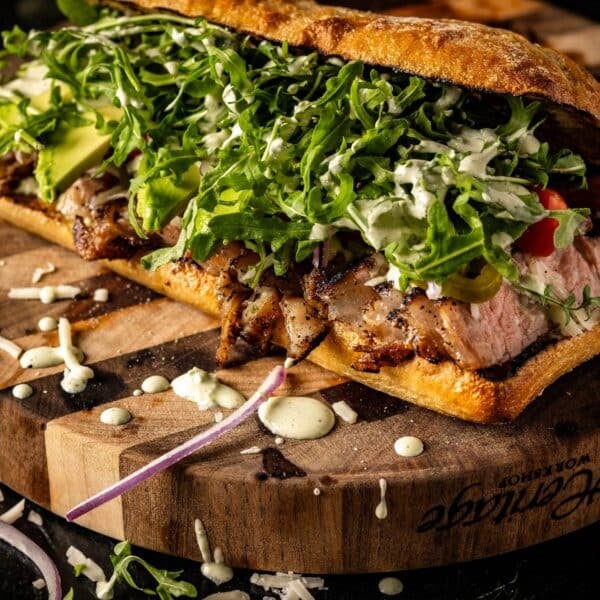

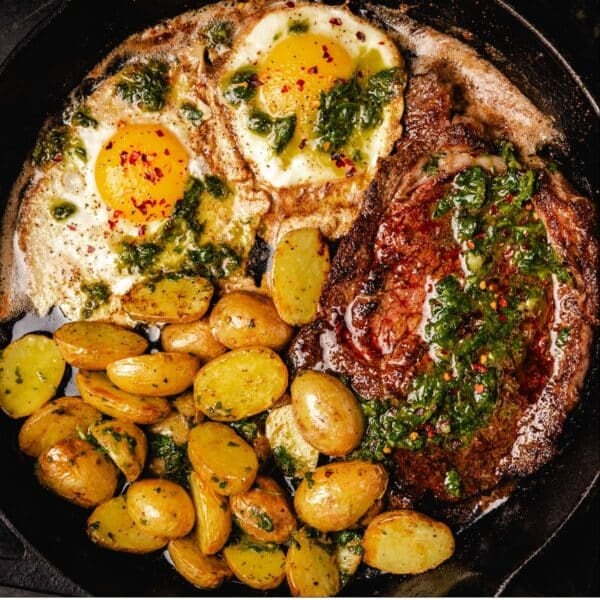
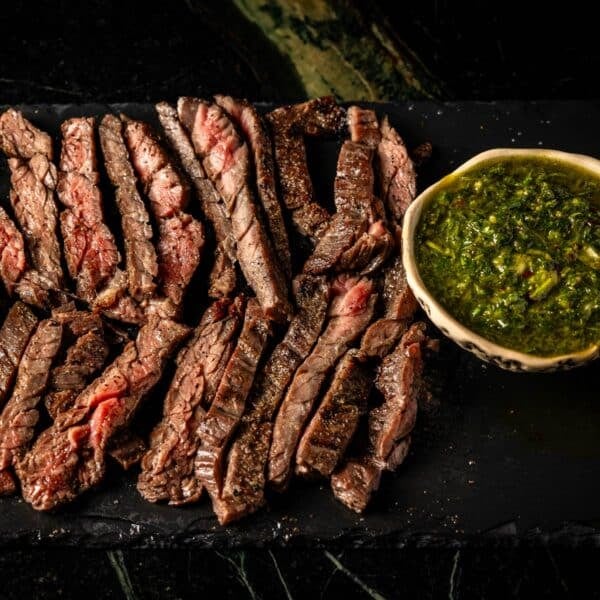





I’ve got two racks of short ribs on my 45 gallon Bar-B-Chef offset smoker, smoking over oak and cherry wood. Threw a couple fully ripe and deep purple poblanos on too. Rubbed in salt, pepper and ground dried cayenne from my garden. I have parchment paper on hand for around midnight and some collards in the pot.
Thanks for the recipe. I used the mustard binder and a locally made rub.Now the ribs are basted with another locally made steak sauce/marinade and are wrapped in a foil tray.We’ll see how they turn out.
I made this when I had people over for a football game. It was a hit!!! Everyone loved it and keep asking me to make it again. I’ll be making it again when I have the group over – it was so juicy and delicious! I froze some leftovers and it was really good when I heated them back up.
For pellet smokers, you should be smoking at 225. Not sure the reasoning behind it but that’s my go to for pellet. When I’m using an indirect source, you can crank it up to 275 and some times 300 and get the same result. Sadly… any bbq instruction is going to be a guideline. You’re going to have to experiment to find your sweet spot. It only took like 5 beef racks for me. Good luck!!
This false. Pellet grills do t have to be set at 225. 275f will give you smoke as well- I’ve owned a pellet grill as well as a ceramic smoker for over 10 years.
Any temp will give you smoke. What’s false? He never said anything about 275 not “giving smoke”. He’s 100% right, 225 is way better for smoking ribs especially “shiners” like this which are thin.
Agreed. I have a camp chef woodwind pro 36 and the first time I followed these instructions, after 3 hours the meat was at 185, not 165. Came out delicious still! The second time I only did 2 hours initially and the meat was right on the money! Next time I’ll try a lower temp
Mine wasn’t dark, not as expected, but definately showed the pink colour of the smoke on the outside. I’ve wrapped it now. Internal temp was 167. Still going, but smelling great!
I used this recipe for smoked back ribs yesterday afternoon and they turned out awesomely good !
Hey Grill Hey,
I used this as a guideline since I had not done beef back ribs on a smoker before. Oak pellets, 275 as recommended and smoke set to 8. Glad I checked them at 2 hrs. Great bark but the ribs were already at 180 internal! I switched gears, brought the temp down to 230 and wrapped the ribs. I took a chance and left them for 1.5 hrs and unwrapped them to find the meat was falling off the bone. I slathered them in my favorite sauce and put them back on for 30 minutes. All told the beef was delicious but like pulled pork wrapped around a bone. We ate an hour and a half early. These ribs were freshly removed from a rib roast and you could really taste the beefiness of the prim rib.
Any clue why my cook went so different than yours? Thanks for putting up the videos and recipes. I use you as a sounding board any time I have a question about which way to go!
First, every piece of meat cooks different. It’s just the nature of the beast. Second, pellet grills are notorious for not actually being at the temperature they say they are. Have you verified your smoker against a known accurate external thermometer? This is most likely the cause.
Thanks for the reply, I am starting to draw the same conclusion about temps. I recently upgraded to a PID controller and more than just this once now I’m having cooks done faster that they should be and faster than I was use to with the old controller.
Had the same issue with my pellet. Used an internal probe to verify the pellet’s reading and the grill was 50* hotter.
I would always recommend cooking based off Temp instead of time. Luckily my pellet smoker has wifi and bluetooth etc so it sets alarms for me. Sometimes the bark doesn’t form great until the internal heat is higher too so it’s just a general guideline in my experience on when to wrap it. I like my bark a bit darker and the temp inside is usually above 170 but i do start checking at 165. If your grill doesn’t have wifi, there are a ton of meat thermometers that do out there though they are a bit pricey.
So good!!!
Sooooo delicious! When you say serving size is 2… is that meaning that a serving size is a half rack, or that it is two ribs?
On the beef back ribs, when you take the wrapped ribs out of the smoker and let them rest do you leave in the paper to rest or unwrap and rest?
Leave them wrapped!